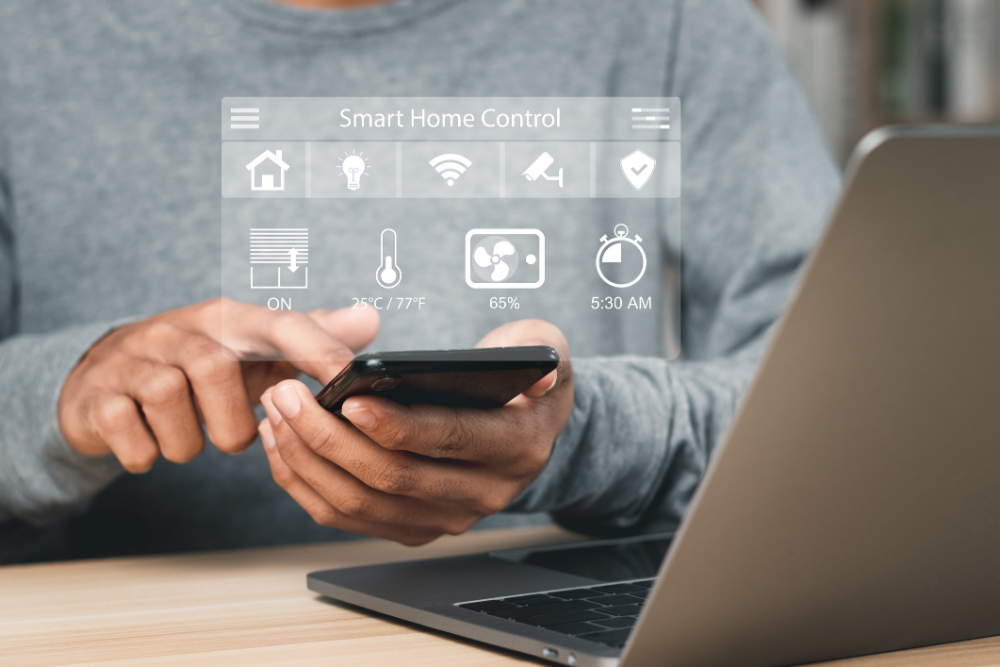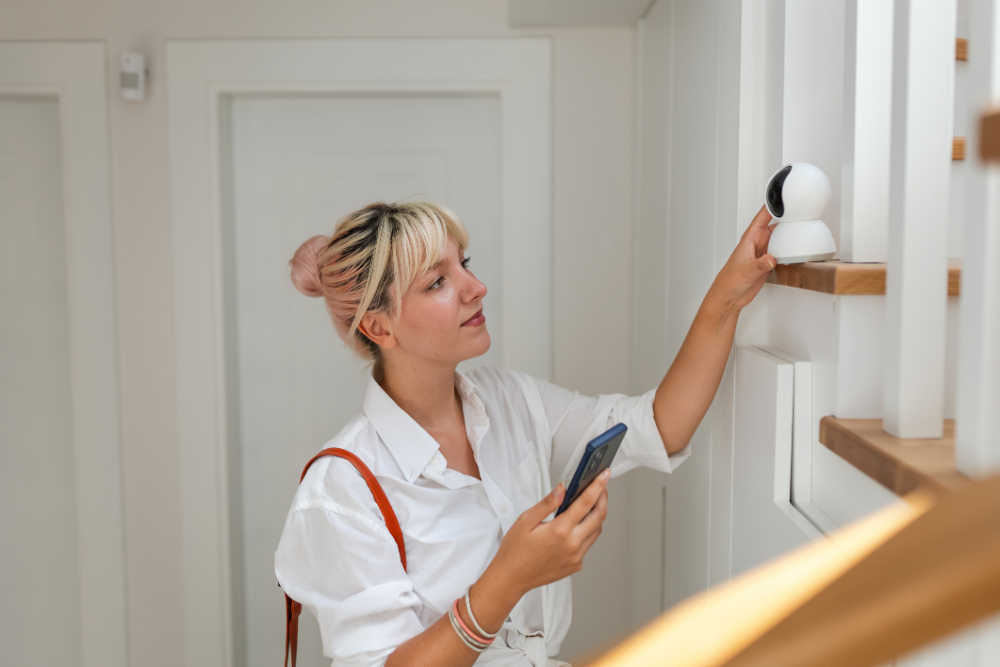
As technology continues to evolve, a growing number of homeowners are seeking to optimize their living spaces with the latest systems and features. Collegeville, PA is a prime example of a small town embracing this trend.
Located a stone’s throw from Philadelphia’s vibrant tech hub, Collegeville gives residents access to a myriad of tech companies who can offer expert guidance on how to maximize different features of smart home.
But the appeal of having a smart home extends beyond practicality and finances – it can also greatly enhance your quality of life in Collegeville. From the security and convenience provided by doorbell cameras and smart locks to the efficiency and comfort afforded by automated lighting and thermostats, the benefits are manifold.
If you’re curious about the different features of smart home and how to incorporate them into your Collegeville property and daily routine, continue reading our guide below:
Table of Contents:
WHAT MAKES A HOME “SMART”?
At its core, a smart home is distinguished by its interconnected network of devices. These can all be controlled from a single point, or a hub, which you can access from a smartphone, tablet, laptop, or game console.
The network lets you schedule specific changes, like adjusting a room’s temperature or turning lights on or off at preset times. Many smart home devices come equipped with self-learning capabilities, which enables them to adapt to your schedules and preferences.
WIRELESS VS. HARDWIRED SYSTEMS?
Smart homes can feature either wireless or hardwired systems, or a combination of both. Wireless systems are simpler to install and are generally more affordable. However, they do require robust Wi-Fi coverage and broadband service. Depending on your location, this might necessitate additional investments in range extenders or hardwired access points.
Hardwired systems are generally considered more reliable and secure, but they can also carry a higher price tag. Their scalability makes them the go-to choice for new constructions or major renovations.
WHAT ARE THE BENEFITS OF HAVING A SMART HOME?

Convenience and Efficiency
Smart home systems allow you to control a wide range of appliances and systems remotely, using a single device such as a smartphone or tablet. This feature greatly simplifies your day-to-day tasks, from adjusting the thermostat to watering your plants.
Moreover, it enables more cost-effective and efficient use of appliances. You can schedule your smart washing machine to run during off-peak energy hours to save on electricity costs, or you can have your smart refrigerator monitor its energy usage and optimize cooling schedules to reduce power consumption.
Enhanced Security
Home automation systems can provide real-time updates and alert you to any unusual motion detected in the home, even when you’re away. For emergencies like break-ins, some systems will even automatically call the authorities.
Moreover, smart doorbells and security systems are part of the Internet of Things (IoT) technology, which can gather and share electronic information to enhance the security of the property. For example, a smart doorbell with facial recognition technology can identify regular visitors or alert you to strangers.
Green Living
Many smart home systems are designed with sustainability in mind. A smart thermostat can be programmed to lower the heat when your house is empty and raise it just before you return, ensuring a comfortable temperature without wasting energy. Smart lights can also be set to turn off when no one is in the room, reducing energy wastage.
By ensuring that appliances and systems are used optimally, certain features of a smart home can help you reduce your carbon footprint and practice a more environment-friendly lifestyle.
HOW CAN YOU INTEGRATE SMART TECHNOLOGY INTO YOUR HOME?

With the many devices and smart home features available on the market, figuring out how to start can be daunting. To help you out, here are six ways you can begin integrating smart home technology into your home:
Choose Your Smart Home Ecosystem and Digital Assistant
A smart home ecosystem refers to the collective network of all the smart devices in your home. It facilitates the interaction, control, and automation of these devices, acting like the central hub that connects and manages your smart appliances.
Digital assistants, on the other hand, are software programs that allow you to control and interact with this ecosystem, often performing tasks or services through voice commands.
Ideally, your smart home ecosystem and digital assistant supports a wide array of devices and a robust suite of features. Here’s a brief overview of some of the most popular digital assistants you can consider:
- Amazon Alexa
Amazon’s Alexa, the pioneer of digital assistants, can control a wide range of devices and automate tasks within your smart home. Alexa’s extensive reach – with regards to device compatibility – and catalog of skills give it an edge. But remember, to make the most of Alexa, you’ll need at least one device with Alexa built-in, like an Amazon Echo speaker.
- Apple HomeKit
Apple’s HomeKit is seamlessly integrated into your Apple devices, offering control through the Home app on your iOS or macOS device. HomeKit’s setup process has improved over time, and the Home app is gradually becoming more intuitive. If you’re already in the Apple ecosystem, HomeKit could be a natural choice. Just look for the ‘Works with HomeKit’ badge when shopping for smart devices.
- Google Assistant (Google Home)
Google Assistant is a universal presence in your daily life if you use Android or Wear OS devices. Its constant presence and accessibility gives it a competitive edge, allowing you to inquire about the morning weather or manage your smart home devices no matter where you are.
Start with Smart Lighting
For those new to smart home technology, starting with smart lighting is a great option. These devices are generally easy to install and can drastically improve the energy efficiency of your home. They offer the ability to schedule on/off times, adjust brightness, and even change colors to fit your mood or the time of day.
When choosing a smart lighting system, it’s important to prioritize the following:
- Compatibility. Your chosen smart bulbs should be compatible with your existing smart home system. This ensures that the bulbs can integrate seamlessly with your setup and that you can control them from your preferred platform.
- Brightness and color options. Consider your lighting requirements in terms of brightness and color. If you like to set the mood or require different light levels for various activities, opt for bulbs that offer a range of brightness levels and colors.
- Energy efficiency. Smart lighting can also contribute to a greener home. LED bulbs consume less electricity than traditional bulbs, leading to significant energy savings over time. Look for bulbs with the ENERGY STAR certification, which meet strict efficiency standards set by the Environmental Protection Agency.
Master Climate Control
Smart thermostats are a valuable addition to any smart home. They empower you to control your home’s climate remotely, optimize energy usage, and create personalized schedules.
What features should you look for?
A smart thermostat comes equipped with a plethora of innovative features. The ability to control your thermostat remotely using your smartphone is a game-changer. But that’s just the tip of the iceberg. Some thermostats are designed to learn your schedule and adapt to your lifestyle, while others employ geofencing technology to determine when you’re home or away, adjusting the settings accordingly.
The design of these smart devices is modern and sleek, often doubling as a stylish addition to your home decor. But more importantly, they provide valuable insights into your energy consumption, helping you make informed decisions about your energy use and potentially saving money in the long run.
How do you choose the right smart thermostat?
Before purchasing a smart thermostat, you need to understand your HVAC system and ensure the thermostat is compatible with it. Also, some smart thermostats might require a continuous power supply, known as a C-wire, to function properly.
Consider if your current thermostat location is optimal, or if it might be worth moving it to a location that better senses your home’s temperature. Lastly, check whether the thermostat is compatible with your existing smart home systems.
Do you need professional installation?
While the installation process is fairly straightforward for the tech-savvy homeowner, don’t hesitate to hire a professional if you’re unsure. It might cost a little more, but the peace of mind that comes with knowing that your smart thermostat is properly installed is well worth it.
Assemble Your Own Entertainment hub
A smart home theater is more than just a big screen and a set of speakers. It’s a fully integrated system designed to deliver high-definition visuals along with top-notch sound, aiming to match or even surpass the quality of commercial movie theaters.
Moreover, you can control your theater experience using voice commands or a single application, eliminating the need for multiple remotes for different devices. You can even sync the lighting and temperature to your entertainment system, creating an automated and fully immersive environment for watching, gaming, and more.
A smart entertainment system is usually made of three components:
- Visual. Your choice of visual components can make or break your viewing experience. Opt for a high-definition smart TV with built-in Wi-Fi for streaming or a projector for a larger-than-life experience. Your room’s size should also be considered to determine the best screen size.
- Audio. Decide between a soundbar for simplicity or a multi-speaker surround sound system for an immersive audio experience. Select speakers that can connect with voice-controlled assistants for hands-free operation.
- Connectivity. Ensure all devices have compatible connectivity options like HDMI, Bluetooth, or Wi-Fi for smooth integration. A universal remote or a smart device app can provide centralized control over all components.
Looking to elevate your home theater experience? Here are some tips to keep in mind when installing your smart entertainment system:
- Optimal speaker placement. Correct placement of speakers can significantly enhance the acoustic experience. This involves placing front speakers at ear level, angling towards your seating area, positioning the center channel directly above or below the TV, and arranging surround speakers to envelop the room with sound.
- Visual calibration. Adjust the display settings on your TV or projector for optimal contrast, brightness, and color balance. For the most accurate picture settings, consider using a calibration disc or professional calibration services.
- Seating and viewing angles. Arrange your seating to ensure an unobstructed view of the screen. The ideal viewing angle is between 30° and 40° from the screen for maximum comfort and immersion.
- Acoustic treatment. Enhance sound quality by treating the room with acoustic panels to reduce unwanted echoes and reverb for clearer sound. For managing low-frequency sounds, consider placing bass traps in room corners.

Automate Your Household Chores
Smart appliances – which include vacuum cleaners, refrigerators, ovens, washing machines, and more – have brought a new level of automation to our everyday tasks, leading to increased efficiency and convenience. These appliances, equipped with cutting-edge technology, can perform tasks autonomously, adapt to our routines, and even learn from our habits to operate more efficiently.
Here are some ways you can automate your daily house chores with smart home technology:
Vacuuming
Modern smart vacuums have evolved into efficient and user-friendly devices. Leading models, such as the Roomba, can be voice-controlled using digital assistants like Alexa.
When considering a smart vacuum purchase, it’s vital to check for features such as Wi-Fi connectivity, mapping sensors, and wheels appropriate for your flooring. Also, the vacuum should have a manageable noise level, an adequate dustbin size, and compatibility with your existing smart home ecosystem.
Pet Care
Smart technology can offer you new ways to ensure that your pets are well cared for, even in your absence.
Smart pet feeders, for example, are designed to automatically dispense food for your pets on a set schedule, ensuring they’re fed on time, every time. This is particularly useful if you have long working hours or frequent travel commitments.
Some of these devices are even equipped with built-in cameras, allowing you to remotely monitor your pets and check in on them from anywhere at any time. Not only does this offer reassurance that your pet is safe and well, but it also allows you to interact with your pets remotely, helping to alleviate feelings of loneliness or anxiety that they may experience when left alone.
Mopping
For homeowners with hard flooring, a smart mop can be an invaluable tool. Like smart vacuums, they are equipped with sensors that allow them to navigate and clean your home efficiently.
Some smart mops offer both vacuuming and mopping capabilities. This dual functionality means these devices can vacuum your floors to remove dust and debris and then mop to ensure a deeper clean. This effectively provides a comprehensive floor cleaning solution, saving you the hassle of using two separate devices.
Laundry
Smart washers and dryers come with features that enable you to remotely control and monitor your laundry cycles via a mobile device. This remote control ability provides you with the convenience of managing your laundry tasks while you’re engaged in other activities, like cooking or watching TV, or even when you’re out running errands.
Certain advanced models can even detect when your detergent supplies are dwindling and automatically place an order for more, ensuring you never run out of detergent in the middle of a wash cycle.
Aside from checking the appliance’s compatibility with your existing smart home system, it’s important to consider its load capacity and energy efficiency, especially if you have a large household or if you tend to wash bulky items frequently.
Prioritize Privacy and Security
To make your smart home a safe haven, start by changing any default passwords on your devices, enabling two-factor authentication whenever it’s available, and regularly updating device firmware to ward off potential threats. You should also take the time to research the privacy policies of device manufacturers to ensure your personal data is handled responsibly.
Considering adding more security features for your smart home? Make sure to invest in:
- A high-quality home security system. A sound home security system is the bedrock of home safety. Seek out a system that includes features such as indoor and outdoor security cameras, door and window sensors, and a high-decibel siren. Some systems also offer additional features like smoke and carbon monoxide detectors.
- Smart doorbells and locks. Smart doorbells let you see who’s at your door from anywhere using your smartphone. Many models also include a two-way talk feature, allowing you to speak to visitors without opening the door. Smart locks, in contrast, let you lock and unlock your doors remotely and send you alerts when doors are unlocked.
- High-resolution surveillance cameras. These add an extra layer of security by enabling you to monitor your home’s exterior. Opt for cameras with high resolution for clear images, night vision capabilities for after-dark monitoring, and motion detection for timely alerts.
As you install and set up your home security system, keep these tips in mind:
- Professional vs. DIY installation. Some home security systems necessitate professional installation, while others can be installed by you. Decide whether you’re comfortable doing it yourself or if you’d prefer the peace of mind that comes with a professionally installed system.
- Coverage. Make sure to install sensors and cameras to cover all potential entry points. Don’t overlook less obvious places like second-story windows or the door connecting the garage to the house.
- System testing. After installation, test the system to ensure everything is working as it should. This includes checking all sensors and cameras and ensuring you receive notifications as expected.
FIND THE PERFECT SMART HOME IN COLLEGEVILLE, PA
With over 18 years of experience in Collegeville and Phoenixville, PA, our team at DeZarate Real Estate Group are your best guides in the home buying process.
Our mission is to understand your unique needs and aspirations, using our resources and expertise to help you find not just a house, but a home where you can create an efficient and comfortable living environment.
Start your search for the perfect home today. Get in touch with us by calling 484.881.2397 or by sending us an email here.
